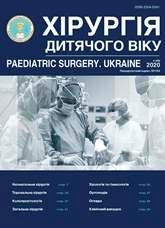Results of treatment of congenital clubfoot after soft tissue release in children
DOI:
https://doi.org/10.15574/PS.2020.69.81Keywords:
clubfoot, children, posteromedial release, surgical treatmentAbstract
Topicality. Widespread use of the method of I. Ponseti allows to significantly reduce the number of reconstructive surgeries and/or reduce their volume. However, if presence the rigid, severe deformities that cannot be corrected with staged plaster casts, or recurrences, surgical treatment is advisable. The literature describes many surgical techniques, the main purpose of which is to reduce the frequency of postoperative complications. And at the same time find the most convenient access to eliminate contractures, further wound healing by primary tension with minimal formation of connective tissue elements.
Objective: to reduce the incidences of complications in the surgical treatment of congenital clubfoot by using a modified surgical approach.
Materials and methods. In the Department of Orthopedics and Traumatology of NCSH «OKHMATDYT» 57 children (72 feet) with a diagnosis of congenital clubfoot underwent surgical treatment using a modified Carroll approach for the period from January 2014 to September 2018. The mean age of patients was 3±0.4 years. 41 of them boys and 16 girls. Bilateral deformity was observed in 12 patients. 48 patients (58 feet) were underwent surgical treatment after initial treatment with staged plaster casts according to the method of I. Ponseti. Recurrences of deformity after surgery was observed in 9 patients (14 feet).
Results. When assessing the immediate results during surgery in all patients, complete correction of foot deformity was achieved. No postoperative complications were noted. Long-term treatment results 2 years after surgery showed that good results were in 12 patients (21±9.53%), satisfactory in 39 (68.4±27.14%) and unsatisfactory in 6 (7±2.18%). Four patients with unsatisfactory results and residual manifestations of deformity in the form of passively corrected isolated adduction of the anterior foot, subsequently underwent surgery to transplant the anterior tibialis tendon to the lateral cuneiform bone. And 2 patients – wedge-shaped resection of the cuboid bone. Indication of which was not the possibility of passive correction of deformity.
Conclusions. The comparative analysis of the obtained results and literature data testifies to the effectiveness of the proposed method of treatment of idiopathic clubfoot in children (using three approaches), as well as in the presence of residual deformity after conservative and surgical treatment.
The research was carried out in accordance with the principles of the Helsinki Declaration. The study protocol was approved by the Local Ethics Committee of participating institution.
References
Babu M, Anand V, Thanigai S. (2017). Results of modified Carroll technique in severe, resistant clubfeet. International Journal of Orthopaedics. 3(2): 801-805. https://doi.org/10.22271/ortho.2017.v3.i2i.86
Carroll NC. (2012). Clubfoot in the twentieth century: where we were and where we may be going in the twenty-first century. Journal of Pediatric Orthopaedics B. 21(1): 1-6. https://doi.org/10.1097/BPB.0b013e32834a99f2; PMid:21946867
Chatupon Chotigavanichaya, Jidapa Wongchareonwatana, Charikdhamma Saelim, Thanase Ariyawatkul, Kamolporn Kaewpornsawan, Perajit Eamsobhana. (2019). Comparison of ponseti method versus surgical treatment in congenital idiopathic clubfoot: A 5-year follow up study. International Journal of Orthopaedics Sciences. 5(3): 666-669. https://doi.org/10.22271/ortho.2019.v5.i3l.1610
Levitsky AF, Karabenyuk AV, Golubenko AA. (2019). Approaches to the surgical treatment of congenital clubfoot in children. Childs health. 14(1): 50-53. https://doi.org/10.22141/2224-0551.14.1.2019.157880
Mahesh Babu B. (2006). Surgical Management of Clubfoot by Modified Carroll's Technique. Doctoral dissertation. Madurai Medical College, Madurai.
McKinney J, Rac MW, Gandhi M. (2019). Congenital talipes equinovarus (clubfoot). American Journal of Obstetrics & Gynecology. 221(6): B10-B12. https://doi.org/10.1016/j.ajog.2019.09.022; PMid:31787157
Pirani S. (2004). A reliable and valid method of assessing the amount of deformity in the congenital clubfoot. St Louis, MO. Pediatric Orthopaedic Society of North America. 115-116.
Sodre H, Bruschini S, Nery C, Mizusaki J. (1994). The Cincinnati Approach in Clubfeet. In: Simons G.W. (eds). The Clubfoot. Springer. New York. 201-202. https://doi.org/10.1007/978-1-4613-9269-9_40
Turco VJ. (1979). Resistant congenital club foot-one-stage posteromedial release with internal fixation. A follow-up report of a fifteen-year experience. The Journal of bone and joint surgery. American volume. 61(6A): 805-814. https://doi.org/10.2106/00004623-197961060-00002
Varma HS, Alok C. Agrawal, Pradeep K Singh. (2013, Jan-Jun). Surgical management of congenital idiopathic clubfoot by twin incisions. Journal of Orthopedics and Allied Sciences. 1(1): 18-21. https://doi.org/10.4103/2319-2585.117383
Wilkinson BG, Glass NA, Cook TM, Morcuende JA. (2018). Surgical Management of Idiopathic Clubfoot in the United States from 1997-2012: An analysis of 11,940 discharges. doi: https://doi.org/10.1542/peds.142.1_MeetingAbstract.297.
Zatsepyn TS. (1947). Vrozhdennaia kosolapost y ee lechenye v detskom vozraste. M.: Medhyz. 37.
Feng Lin. (2016, Aug). Observation of curative effect by Carroll operation approach in the treatment of congenital talipes equinovarus. Chinese Practical Medicine. 8–9.
Downloads
Published
Issue
Section
License
The policy of the Journal “PAEDIATRIC SURGERY. UKRAINE” is compatible with the vast majority of funders' of open access and self-archiving policies. The journal provides immediate open access route being convinced that everyone – not only scientists - can benefit from research results, and publishes articles exclusively under open access distribution, with a Creative Commons Attribution-Noncommercial 4.0 international license(СС BY-NC).
Authors transfer the copyright to the Journal “PAEDIATRIC SURGERY.UKRAINE” when the manuscript is accepted for publication. Authors declare that this manuscript has not been published nor is under simultaneous consideration for publication elsewhere. After publication, the articles become freely available on-line to the public.
Readers have the right to use, distribute, and reproduce articles in any medium, provided the articles and the journal are properly cited.
The use of published materials for commercial purposes is strongly prohibited.

